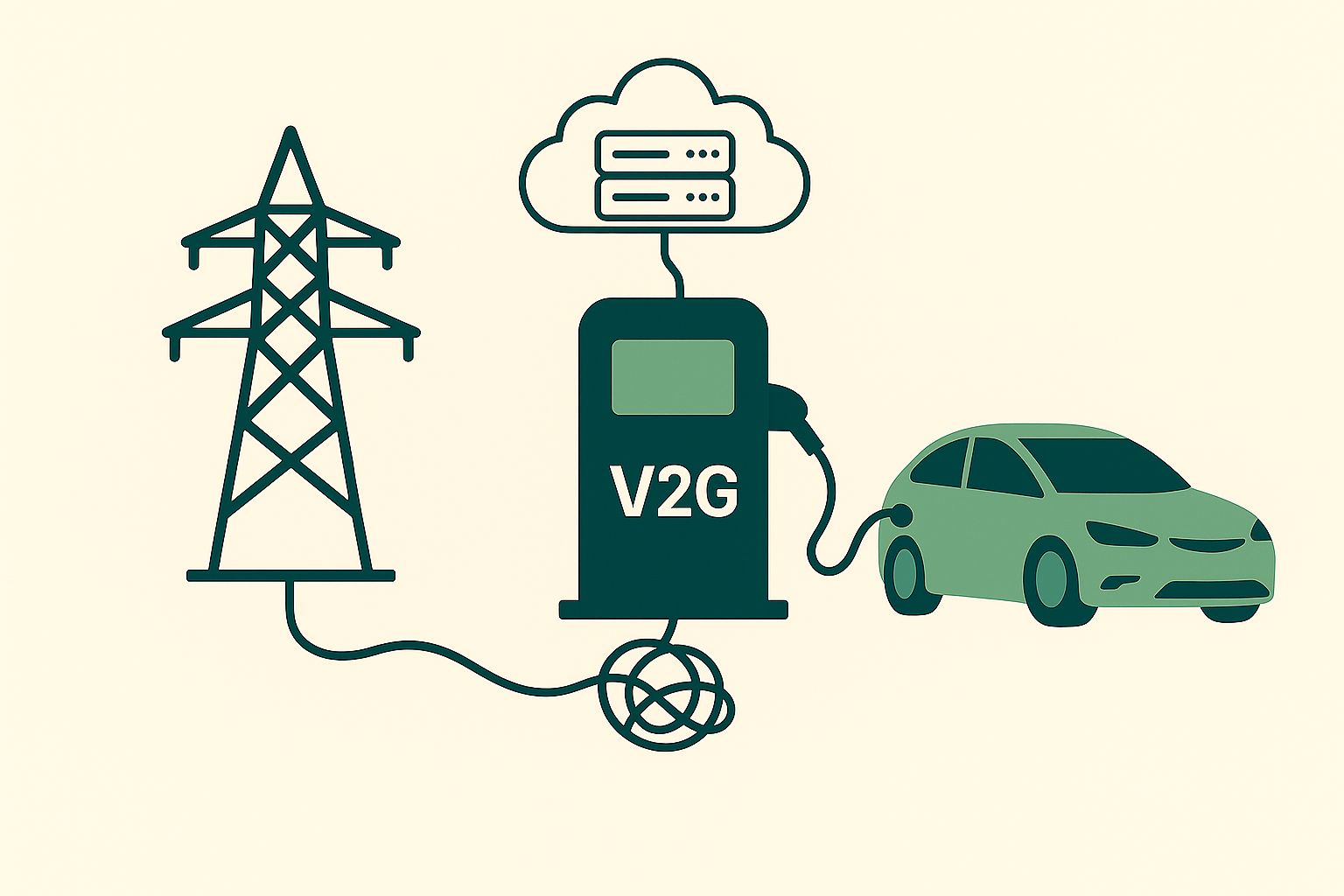- V2G News
- Posts
- Volume 1 | Issue 7
Volume 1 | Issue 7

In this edition of V2G News, we tackle the big roadblock: interoperability. Until EVs, chargers, and grid systems can speak the same language, scaling will remain slow and fragmented. Our feature breaks down what true interoperability looks like and how industry leaders are closing the gaps. We also spotlight a new academic study (Electric Vehicles as Grid Resources: Barriers to V2G in the U.S.) showing market and institutional hurdles, not tech, are holding back progress.
We also highlight how V2G is entering the mainstream, with coverage now appearing in major national outlets, from Forbes, which explored how V2G and virtual power plants could help meet surging data center demand, to USA Today, where a reporter powered her home for a week using an EV. Together, these stories signal that bidirectional charging is beginning to move beyond the niche and become part of the national energy conversation. Plus, we round up the latest V2G projects and breakthroughs from around the world, shaping the future of the grid.

V2G Insights
Vehicle-to-Grid Interoperability: From Custom Integration to Common Infrastructure
October 21, 2025

Vehicle-to-grid (V2G) technology offers a compelling vision: electric vehicles that don't just consume electricity but also support the grid with stored energy and fast, controllable power flow based on real-time grid conditions. That vision is already visible in pilots and early deployments. But achieving scale beyond custom integrations hinges on one thing above all: interoperability: equipment and software that actually work together across brands, sites, and operators in the wild.
What Interoperability Means
Interoperability means any compliant[1] EV can plug into any compliant charger and deliver the same services (e.g., grid services or vehicle-to-building functions) regardless of brand, site, or operator. Today, that's not the norm. An electric school bus that exports power at one depot may not work when connected to a different vendor's bidirectional charger at another site. Likewise, an electric pickup truck that provides emergency backup power at the owner's home may not work with a neighbor's system from another manufacturer. These gaps aren't just inconvenient; they raise integration costs and make it hard for utilities and fleet operators to count on V2G capacity at scale.
A core reason is the continued use of proprietary protocols or vendor-specific variations inside otherwise open standards. Open standards create the common rulebook, but true compatibility only emerges when they're implemented consistently. In practice, interoperability is achieved when vendors build their products to open standards and demonstrate, through certification and multi-vendor testing, that these products operate together effectively in the field.
Note: The author would like to thank James Mater of QualityLogic and Matt Zebiak of 2050 Partners for their review and comments on an earlier draft of this article. Any remaining errors or omissions are the sole responsibility of the author.
[1]Compliant refers to adherence to the relevant open standards governing interoperability for both unidirectional and bidirectional charging.

V2G Intelligence
Understanding the Real Barriers to V2G Adoption in the U.S.
October 21, 2025

A new preprint study titled Electric Vehicles as Grid Resources: Barriers to Vehicle-to-Grid (V2G) in the United States, authored by researchers from the University of Colorado Denver and North Carolina State University, offers one of the most comprehensive examinations to date of why V2G adoption remains limited in the U.S.[1] Although still under peer review, the paper provides valuable insights for utilities, policymakers, and technology developers seeking to accelerate bidirectional charging deployment.
Purpose of the Study & Methods
The research team set out to understand the socio-technical and institutional barriers slowing the integration of vehicle-to-grid (V2G) technologies. Despite two decades of technical feasibility demonstrations, V2G participation remains confined to small pilots. The authors note that the U.S. lacks market frameworks that properly value and compensate the energy and grid services EVs can provide. Their goal was to identify what’s holding the industry back, and how different stakeholder groups perceive the challenges.
To capture a broad range of perspectives, the researchers conducted 33 in-depth interviews with 42 participants across utilities, automakers, school districts, government agencies, and V2G pilot operators.
A distinctive feature of the study is its use of the Extended Unified Theory of Acceptance and Use of Technology (UTAUT2) framework, a behavioral model that explains why individuals and organizations adopt, or resist, new technologies. UTAUT2 was adapted here to interpret institutional decision-making around V2G.
[1]Soderman, Crystal and Kim, Serena and Kim, Serena and Yip, Jen and Shirgaokar, Manish, Electric Vehicles as Grid Resources: Barriers to Vehicle-to-Grid (V2G) in the United States. Available at SSRN: https://ssrn.com/abstract=5459874 or http://dx.doi.org/10.2139/ssrn.5459874.

V2G Finds
Bidirectional charging continues to gain national visibility, with USA Today publishing a feature in which tech columnist Jennifer Jolly powered her home for a full week using GM’s Sierra EV and Home Energy System, transforming the concept from theory to tangible proof. “This is what we’ve been waiting for—real-world proof that the technology actually works,” said Zach Woogen, Executive Director of the Vehicle Grid Integration Council. “For years, this was theory and pilot programs. Now we’re seeing it in people’s homes. That’s a huge step forward.” Woogen described bidirectional charging as “a relief valve for an overworked grid,” noting that the energy already stored in U.S. vehicles may exceed all grid-scale batteries combined. Following Forbes’ recent coverage (see next) linking V2G to data center resiliency, this USA Today story underscores how bidirectional charging is beginning to enter the national conversation as a solution for energy reliability and grid flexibility.
10/17/2025
A recent Forbes Council post by ChargeScape CEO Joseph Vellone highlights how vehicle-to-grid (V2G) and virtual power plant (VPP) technologies can play a pivotal role in meeting the surging energy demands of data centers driven by AI growth. As grid constraints delay new capacity, V2G offers a flexible, distributed source of power and resiliency. The piece underscores growing mainstream recognition, from top-tier business media to industry leaders, that bidirectional EV charging isn’t just a mobility solution, but an integral part of future grid strategy.
10/15/2025
In an interview with energate, Marcus Fendt of The Mobility House Energy says V2G is technically ready but still awaits market and regulatory alignment. He predicts that by 2026 nearly every new EV will be V2G-capable and points to Germany’s MiSpeL proceeding as a breakthrough moment to remove double grid charges and enable fair market participation. With Europe advancing on policy clarity while the U.S. lags on interconnection and market access, Fendt’s remarks underscore that the shift from pilot to product hinges less on technology than on decisive regulatory action.
10/17/2025
A new report from BCC Research projects the global vehicle-to-grid (V2G) market to grow from $6.3 billion in 2025 to $16.9 billion by 2030, a robust 21.7% compound annual growth rate. The study underscores how expanding EV adoption, government incentives, and advances in bidirectional charging and smart grid technologies are accelerating V2G deployment worldwide. It also highlights the growing importance of regulatory alignment, interoperability, and infrastructure investment across key markets in North America, Europe, and Asia-Pacific. For V2G News readers, this analysis reinforces the global momentum behind grid-integrated EVs, pointing to a rapidly maturing ecosystem where technology innovation and policy support are converging to unlock new value streams for utilities and EV owners alike.
10/13/2025
Dutch carsharing platform MyWheels is deploying another 50 bidirectional chargers in Eindhoven, following its earlier rollout with We Drive Solar in Utrecht. The initiative allows shared EVs to absorb excess solar energy and discharge it later to support grid stability — a model that pairs shared mobility with distributed energy storage. As Alderman Robert Strijk noted, the pilot aligns with Eindhoven’s goal of building a “reliable, shared, and sustainable” energy system. For V2G News readers, this project illustrates how carsharing networks can accelerate the adoption of V2G, creating both economic and environmental benefits by turning shared vehicles into flexible grid assets.
10/6/2025
A new partnership between The Mobility House and Itron aims to accelerate fleet electrification in New York by combining advanced load management and grid-edge intelligence. The project integrates The Mobility House’s ChargePilot energy management system with Itron’s IntelliFLEX DERMS, enabling chargers to respond dynamically to grid conditions and avoid costly infrastructure upgrades.
While the initial focus is on optimizing managed charging for school buses, the underlying architecture, real-time coordination between vehicles, chargers, and grid systems, represents a critical stepping stone toward bidirectional energy flows and full V2G integration. As CEO Greg Hintler noted, solving the interconnection backlog is key to unlocking the next phase of fleet electrification, one where vehicles not only draw from but also support the grid.
10/17/2025
A recent article by Ed Lynch-Bell, Cybersecurity and V2G: Consumers need a secure connection for their batteries on wheels, highlights the growing urgency of protecting connected energy devices as vehicle-to-grid (V2G) technology scales. While focused on Australia, the piece raises universal concerns about how EVs, chargers, and grid systems exchange data securely — a prerequisite for consumer trust and market growth. The message aligns with V2G News’s recent feature on interoperability: as the global V2G market expands, cybersecurity must be treated as an integral layer of interoperability, ensuring that the same open standards enabling connection also safeguard it.tem means making security an integral standard, not an afterthought.
10/14/2024

Enjoying V2G News? Know someone who’d benefit from staying ahead in the fast-moving world of V2G? Twice a month, we deliver expert insights, top headlines, and coverage of the latest innovations—free, straight to their inbox. 👉 Share this link.
